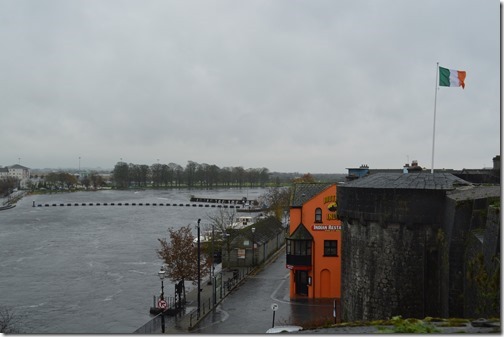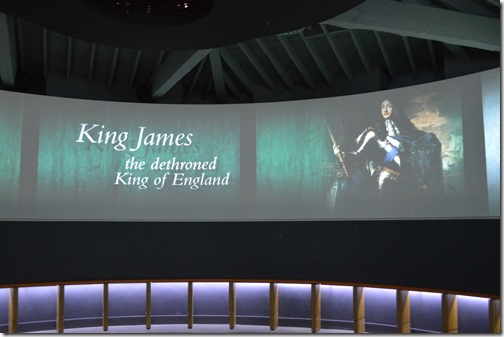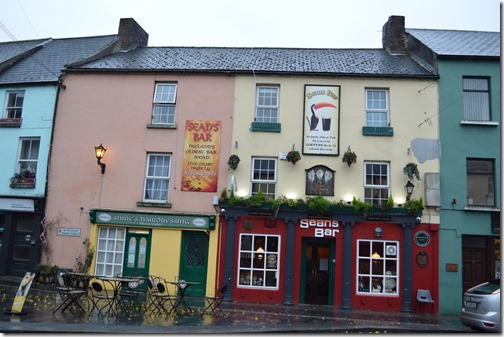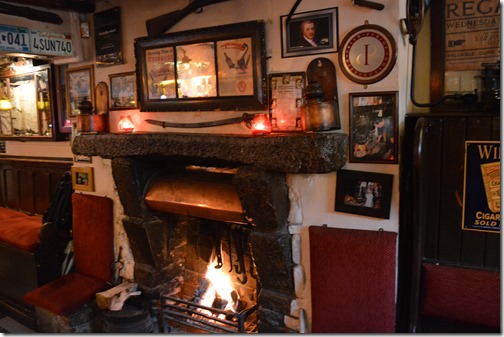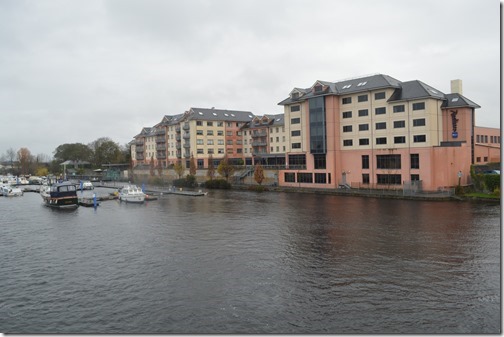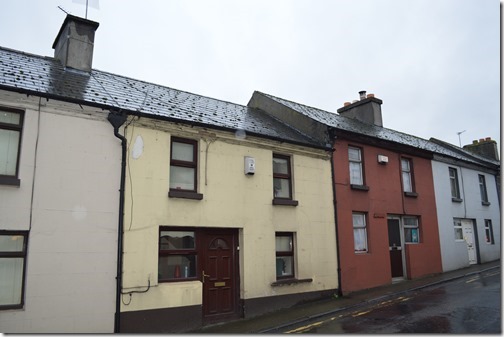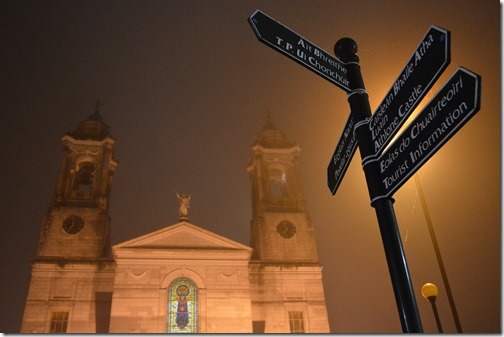The rain was not too bad. It only blew a little sideways. This is Ireland. In Athlone, on average, it rains 13 days in November. If you want dry weather, then come in June when it only rains 10 days on average.
The smell of burning peat was a familiar scent I had not smelled in 16 years since I was last in rural Ireland. Peatlands have provided an energy resource for centuries. The wet soil over several millennia since the Ice Age has created bogs that cover much of Ireland. An Irish cultural tradition is cutting the turf from bog peatlands and drying the turf.
For Peat’s Sake
Athlone is in bog land where peat is cut from the soil for turf. When I traveled around County Donegal in 1997, most rural houses had a pile of dried peat turf outside the house for use as a heating source, in the way you see a wood pile in forested regions of the U.S. In the 1990s only Finland and Russia consumed more peat than Ireland. Since 1990 the use of peat fuel for home heating has decreased 67%.
Bog conservation in Ireland is a major issue these days with environmental protections designating large portions of bog land as Special Areas of Conservation and Natural Heritage Areas. Turf cutting has been restricted in many of these areas. Bogs act like rain forests in trapping carbon dioxide from the atmosphere and pressure from the EU forced Ireland to work toward conserving and preserving the remaining bogs in environmentally sensitive areas of importance.
Athlone Attractions
There are two main attractions in Athlone. There is Athlone Castle, a 12th century castle built and destroyed and refurbished many times over the centuries, and Sean’s Bar, the oldest pub in Ireland according to the Guinness Book of World Records. I visited both attractions.
Athlone Castle
The significance of Athlone is its location on the Shannon River at a place where the river could most easily be forded. The castle is on the west bank of the river. Athlone Castle was originally built of timber around 1129, followed by stone construction in 1210. Edward I, the great castle builder, added a curtain wall and towers to the fortifications in 1276-85 to strengthen Athlone Castle against resurgent Irish. This is the same Edward Longshanks depicted in the movie Braveheart.
In 1315, Athlone Castle was burned by forces of Ruaidri O’ Conchobair, an ally of Edward the Bruce in support of the Scottish struggle against the English. The castle changed hands several times between Irish insurgents and English allies.
Admission is 8 EUR, although I only paid 6 EUR since I saw a brochure in the Radisson Blu Athlone stating guests can show their hotel key card for a 25% discount.
The stone bridge over the Shannon at Athlone was constructed in 1567 and lasted 300 years.
The interactive displays were opened to tourists only two years ago and provide a history of Athlone Castle. The castle is central to the history of the town. The siege of Athlone in 1690-91 was a major event in European history when Colonel Richard Grace, governor of Athlone, appointed by King James II (Catholic), defended the castle from a detachment of King William III’s (Protestant) army. An army of 20,000 bombarded Athlone Castle from the east bank during the great siege of Athlone and the castle eventually fell to King William’s army. The battle was truly an international affair with the Williamites led by a Dutch General leading a Danish army.
The castle seen today is mostly a design from the Napoleonic Wars of the early 1800s. In 1922 the castle was occupied by forces of the Irish Free State after independence from Britain and the castle served as a garrison until 1969 when the castle became a National Monument of Ireland.
There is not much else to see in Athlone in the off-season, except the Castle. The nature trails were flooded and the center of activity seems to be any of the forty or so pubs in town.
Sean’s Bar, Ireland’s Oldest Pub
I visited more than 50 pubs around Ireland over the eight weeks my wife and I toured the country in the summers of 1997 and 1998. I don’t recall being in any pub that had a selection of more than five beers: Guinness, Smithwick’s, Carlsberg, Kilkenny, Budweiser or Coors, and Murphy’s or Beamish. The first three beers were available at all pubs and often those were the only three beers served.
In a tiny pub on Arranmore Island, County Donegal in 1997, when I commented about the small selection of beers, an old Irish man said to me, “Too much choice is not necessarily a good thing.â€
The two pubs I visited today in Athlone revealed more beer choices. Heineken, Peroni, and Molson’s on tap is a change in Irish culture. When I commented on the variety of beers, a young man told me that the change was a result of economic boom in Ireland, referred to as the ‘Celtic Tiger’, for the decade when Ireland had the highest economic growth in Europe from 1995 to 2000. Ireland continued strong growth until a dramatic reversal in 2008 with the global recession. The rise of disposable income created demand for new products. Another young woman told me many pubs even serve cocktails to attract a younger crowd who do not drink beer. Statistics show beer drinking is in decline in Ireland. The rise of off-licence and supermarket beer sales are also impacting pubs in Ireland.
Sean’s Pub is listed in the Guinness Book of World Records as the oldest pub in Ireland with ownership records dating back to 900 AD. I dropped in for a 4.10 EUR pint of Smithwick’s. Wow.
I stayed at the Radisson Blu Athlone. There is also the Sheraton Athlone in town that I can see from my hotel room about a kilometer away. The 12-story Sheraton Athlone appears to be the tallest building in the city.
I was at an off-licence store and chatting with the clerk. He asked why I came to Athlone? When I told him the Radisson Blu hotel rate was really low, he quipped, “There is a reason for that. This town sucks.â€
My wife understands why I came here. We spent one month traveling around rural County Donegal in June and July 1997 with a week in Northern Ireland. In 1998 we returned to Ireland for three weeks in County Cork and County Kerry. In two months of traveling around Ireland, we only spent two days in Dublin. The city was too fast-paced for us. It will be interesting to see how we feel about London this week and what I think about Dublin next week.
The first thing I noticed after getting off the bus in Athlone was the smell of peat burning. A local asked me,  “How can you smell peat?”
Easy. Ireland is the only place I have ever been with that smell. The smell of peat burning brought back warm memories from our trips in the 1990s of sitting by pub fires trying to dry our wet clothes after a day out hiking in the rain.
And the rain fell hard in Athlone. I can still feel the dampness on my shoulders from walking around a few hours in the rain. I planned to hike the ‘Big Meadow’ only to find the big meadow is under a foot of water. As it turns out, the Big Meadow forms part of The River Shannon Callows Special Area of Conservation, a European Union designated conservation site for protection of wildlife. Callows are seasonally flooded wetlands. And this is the flooded season.
As I walked through the streets of Athlone, one of my thoughts was, I find most any place enjoyable as long as I have the proper clothing and I am not in fear of my safety. I enjoy walking neighborhoods and looking at where people live.
I’ll spare readers my selfie I took standing in front of the doorway. What is not obvious in the photo was apparent to my eye as I walked this street. These doors are under 5’6†tall. I tried to snap a couple walking past the door, then the woman turned and looked at me and I missed the surreptitious shot.
The first night was thick-o-fog all the way from Dublin Airport to Athlone. Walking around town in the fog was tough for photography.
Irish sign posts bring back memories. When we traveled remote County Donegal in 1997, one thing I noticed was pranksters moved some of the road signs to point to wrong directions.
That was my day in Athlone, Ireland.
A little more on Ireland to come. Time to catch my RyanAir flight to London.



